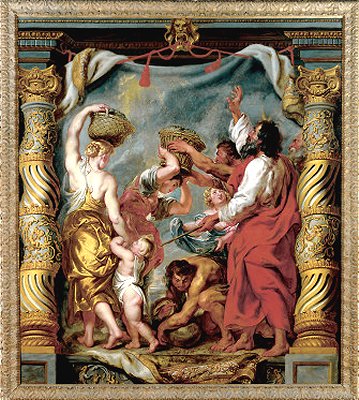 |
|
THE GATHERING OF THE MANNA
Peter Paul Rubens Femish
1577-1640
SN 211 Oil on Canvas c1625
by Robert Anderson
ARTIST
Peter Paul Rubens, along with the Italian sculptor Gianlorenzo Bernini,
was one of the greatest artists of the 17th century. His canvases can be said to define
the scope and style of high baroque painting through their energy, earthy humanity and
inventiveness. A devoutly religious man, a man of learning and a connoisseur of art and
antiquities, he was also a man of the world who succeeded not only as an artist but as a
respected diplomat in the service of Isabella and Albrecht of the Spanish Netherlands.
Travels to Venice where he studied Titian, Veronese & Tintoretto
freed his artistic talent from rigid classicism. While he did incorporate copies of
classical statues in his paintings he always avoided the appearance and coldness of stone.
To the contrary, his nudes, for which he became famous, always depicted an ample female
form of vitality and good health as well as of sensuousness. His mastery of color along
with his knowledge of antiquity is seen particularly in his mythological paintings. |
As court painter and confidant to the Archduchess Isabella Clara
Eugenia, Rubens recognized the role art was to play in the Counter Reformation. His genius
found expression in his designs for the Triumph of the Eucharist tapestries which he and
his assistants completed between 1625 and 1628.
Knighted by two monarchs and master of a successful workshop, Rubens
became rich and famous in his own time. Having executed over 3,000 paintings, woodcuts and
engravings of all types, he died the most respected artist of his time in 1640.
SUBJECT
This painting depicts the story told in the Old Testament ( Exodus 16:
14-35) of the Israelites receiving food from heaven as they wandered in the desert. God
spoke to Moses and promised that he would send bread to the starving Israelites. One
morning, manna - small round loaves of bread - dropped from heaven and the Israelites were
saved from starvation. They continued to be supplied with manna from heaven for the next
forty years until they came to the borders of the land of Canaan.
PAINTING
The painting is conceived as a tapestry hung between columns which are
of a composite form with Ionic capitols and twisted shafts, so-called Solomonic columns,
derived from the Temple of Solomon. The "tapestry" is suspended from a support
rope and spills over the bottom apron of the "stage".
Small beads of manna rain from heaven to the amazement of Moses, a
powerful and commanding figure who stands at the right gesturing toward heaven in thanks.
Moses holds a rod in his left hand and wears a bright red cloak. Note: Tapestry cartoons
are reversed so that weavers can work from the back side of each tapestry. The tapestry
woven from this cartoon would therefore show Moses on the left of the picture holding the
rod in his right hand.
Moses is balanced by a female Israelite modeled on a painting by
Raphael, whose sturdy arms and back support a basket overflowing with manna. Other
Israelites gather manna which is a prefiguration of the bread/body of Christ in the
Eucharist of the new Testament ( Matthew 26:17-30, Luke 11: 1-4 and John 6: 27-35).
HISTORICAL CONTEXT
The cycle of eleven paintings of The Triumph of the Eucharist was
commissioned by the Archduchess Isabella who was the daughter of Philip II of Spain and
the Governor of the Spanish Netherlands. It was planned as a gift for the convent of the
Descalzas Reales in Madrid in 1625 where it still hangs today. This Franciscan Order of
Poor Clares was one with which Isabella was closely associated.
The series is a mixture of allegory and religious propaganda intended
to promote the worship of the Eucharist (ie the bread and wine consecrated as the body and
blood of Christ and distributed at communion) which had been strengthened recently by the
Council of Trent and which constituted an important element in Counter Reformation
Catholicism.
This was a time of great concern on the part of the Catholic church as
it attempted to correct not only the abuses of the clergy but also to reaffirm its tenets
/ dogma in the face of attacks by the Protestant Reformation.
ringlingdocents.org
|
